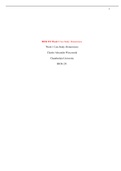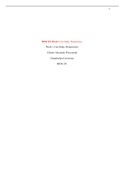Bios 251 case study - Study guides, Class notes & Summaries
Looking for the best study guides, study notes and summaries about Bios 251 case study? On this page you'll find 58 study documents about Bios 251 case study.
Page 2 out of 58 results
Sort by
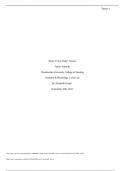
-
BIOS 251 Week 4 Case Study: Tissue – Graded An A+
- Case • 5 pages • 2024
-
- $9.49
- + learn more
BIOS 251 Week 4 Case Study: Tissue – Graded An A+ Describe the five different layers of the skin. The five layers of the skin are known as the epidermis, which is divided further into five different layers. The layers are stratum corneum, stratum lucidum, spinosum, granulosum, and stratum basale. All five of these layers contain different characteristics and responsibilities for the skin. - Stratum corneum is the most superficial layer and is the one that is visible, so ...
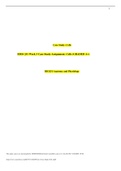
-
BIOS 251 Week 3 Case Study Assignment: Cells (GRADED A+)
- Case • 4 pages • 2022
- Available in package deal
-
- $10.99
- + learn more
Case Study: Cells BIOS 251 Week 3 Case Study Assignment: Cells (GRADED A+) BIO251 Anatomy and Physiology 1. Brian indic ates that the mutation is in a gene found in the mitochondrial DNA. What does Brian mean by that and why did he signify mitochondrial DNA? The mutation found in the gene in the mitochondrial DNA is because mitochondria produces much of the energy that cells need to function. In the mitochondrial DNA, which is separate from the DNA of the cell, is affected by the gene mutations,...
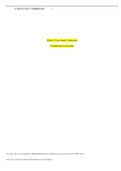
-
BIOS-251 Week 2 Case Study Assignment: Chemistry (RATED A)
- Case • 8 pages • 2022
- Available in package deal
-
- $10.99
- + learn more
Week 2 Case Study: Chemistry Chamberlain University Fats and Carbohydrates Fats and Carbs both have a common relation with producing energy for the body’s use; however, there’s a differen ce. [With fats when they release energy, it takes time for it to be metabolized, whereas carbs are fast-acting with the producing energy for the body] (Saladin 2020). Now when energy is not needed some of these carbs can be converted to fat (depending on what was consumed) which can be stored for later use ...
BIOS 251/BIOS251 Anatomy and Physiology I with Lab Week 1 Case Study: Homeostasis (Latest, 2022/2023)
BIOS 251/BIOS251 Anatomy and Physiology I with Lab Week 1 Case Study: Homeostasis (Latest, 2022/2023)

-
BIOS 251 Week 5 Case Study Assignment: Integumentary System (RATED A)
- Case • 6 pages • 2022
- Available in package deal
-
- $10.99
- + learn more
OL Lab 5: Integumentary system Learning Objectives: • Identify the tissue and cellular features of the skin. • Identify the structures associated with the skin. • Correlate the anatomical fe atures to its functions. • Identify the role of the skin in thermoregulation and wound healing. Part A: Anatomy of the skin I. Microscopic anatomy of the skin. Complete the table using the image provided: II. Gross anatomy of the skin. Complete the table using the image provided. Structure Function A...
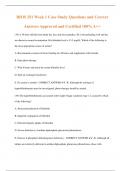
-
BIOS 251 Week 1 Case Study Questions and Correct Answers Approved and Certified 100% A++
- Exam (elaborations) • 17 pages • 2024
- Available in package deal
-
- $8.39
- + learn more
(19) A 30 hour old full term infant has face and chest jaundice. He is breastfeeding well and has an otherwise normal examination. His bilirubin level is 15.5 mg/dL. Which of the following is the most appropriate course of action? A. Recommend cessation of breast feeding for 48 hours and supplement with formula. B. Start photo-therapy C. Wait 6 hours and retest the serum bilirubin level D. Start an exchange transfusion E. No action is needed - CORRECT ANSWER -B. Although the etiology o...

-
BIOS 251 Week 7 Case Study Assignment: Joints | Download To Score An A
- Case • 4 pages • 2022
- Available in package deal
-
- $10.99
- + learn more
Week 7 Case Study: Joints Chamberlain University BIOS251-12278 Week 7 Case Study: Joints Describe the different classes o f joints based on structure and function. Functional: based on degree of motion or the amount of movement Synarthroses: immovable joints. Found in skull joints, teeth sockets, distal joint of tibia and fibula Amphiarthroses: slightly movable Found in intervertebral joints, pubic symphysis, manubrium, tibiofibular, and body of the sternum. Diarthroses: free movable joints. Fou...
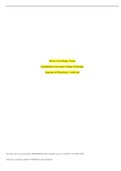
-
BIOS 251 Week 4 Case Study Assignment: Tissue (Already graded A)
- Case • 3 pages • 2022
- Available in package deal
-
- $10.99
- + learn more
Week 4 Case Study: Tissue Chamberlain University College of Nursing Anatomy & Physiology 1 with Lab Week 4 Case Study: Tissue Required Resources Read/review the following resources for thi s activity: ● Textbook ● Weekly Concepts ● Minimum of 1 scholarly source Scenario/Summary Steven and Brenda had eagerly anticipated the birth of their first child, a boy named Garth. The first year was joyous and Garth grew normally with no apparent problems other than some trauma induced blistering of t...
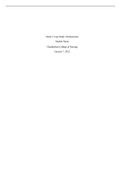
-
BIOS 251 Week 1 Case Study; Homeostasis
- Other • 2 pages • 2022
-
- $20.49
- + learn more
1. Differentiate between anatomy andphysiology. 2. Explain the characteristics oflife. 3. What is homeostasis and why is itimportant? 4. Explain what happens in negative feedback regulation and give anexample. 5. Explain what happens in positive feedback regulation and give anexample.

How did he do that? By selling his study resources on Stuvia. Try it yourself! Discover all about earning on Stuvia

